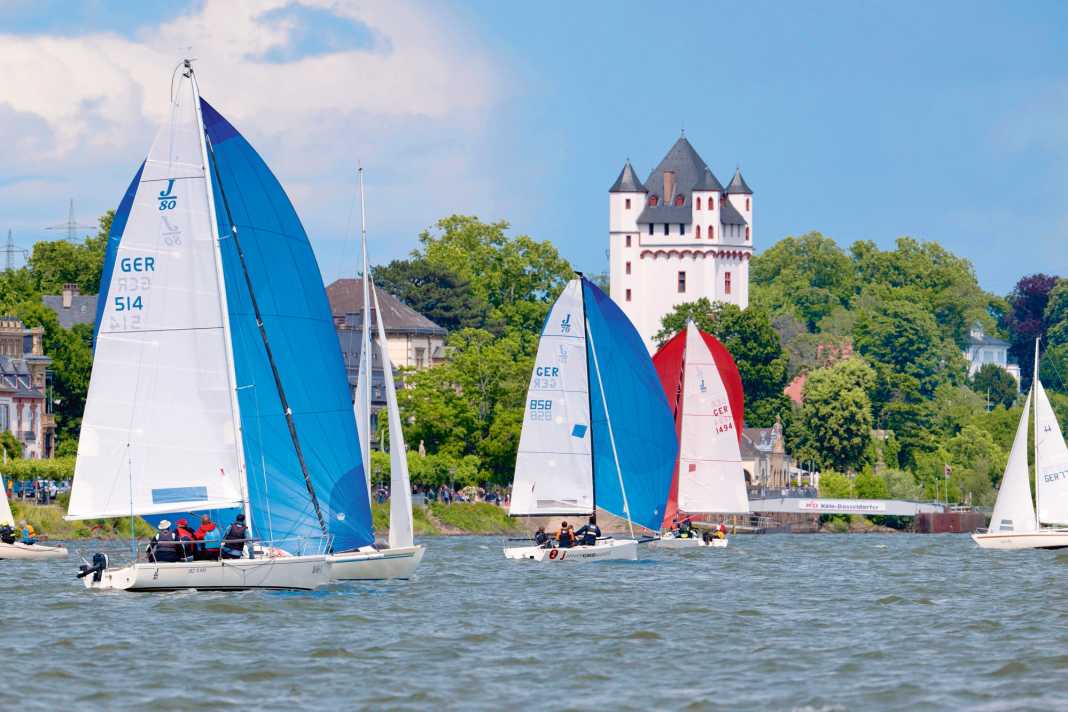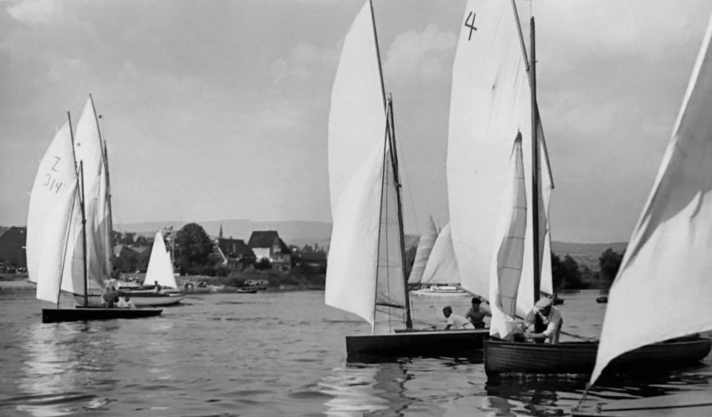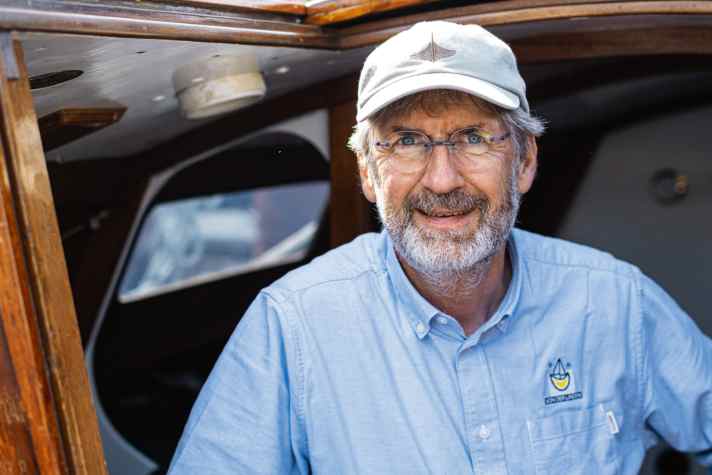





On the first race we head down to the valley," Ulrich Rosskopf introduces the helmsman's briefing. "For safety reasons and because it's so beautiful!" The 60-year-old is head of organisation for the Rhine Week, Germany's largest regatta on a river, and the longest in the country at that. The organising sailing club changes every year, this time the more than 300 participating sailors have come to the Rheingau Sailing Club (SCR) in Walluf, which has taken over the organisation on the occasion of its 125th anniversary.
The start, explains organiser Rosskopf, will be at river kilometre 508, with sailing up to kilometre 514. "We will give you as much space as possible: both the start and finish line will be across the entire width of the river," continues Rosskopf.
Also interesting:
On the water, the starts take place in five different groups. "The red group starts first, then blue, orange, purple and finally the yellow group," said Rosskopf at the helmsmen's briefing. The organisers had not expected the high number of entries this year. "We didn't expect this rush," Rosskopf, who everyone calls Uli during the weekend, is quoted as saying on the Regattagemeinschaft Rhein website. The organisation team was downright "overwhelmed" by the interest shown by the sailors.
Of the 100 registered boats, 87 will make their way to the starting line with their crew for at least one regatta race. "For many inland sailors, the Rhine Week is an integral part of their Whitsun weekend," says Helge von der Linden. The Managing Director of the boatbuilding supplies wholesaler of the same name is the First Chairman of the Rhine Regatta Association. The association was founded in 1999 to organise the annual Rhine Week. "Previously, there had only been a loose committee between the sports managers to organise the Rhine Week and coordinate other regatta dates," he explains.
Two races with homecoming
The members are several sailing clubs that had previously met and agreed loosely. "The constant structure now means that we can enter into long-term partnerships with sponsors and not every club has to start afresh every year," he explains. Fortunately, in addition to the large sponsors such as Pantaenius and the von der Linden company, they also have a number of smaller companies, some of which are run by regatta sailors and contribute to the cost-covering financing of the event.
Two races are planned for Whitsun Saturday. In the first, the boats are only sent on a cross against the wind. They will sail "downstream" with the current. In the second race, the start will be in the same direction. The finish mark of the first race, south of the Mariannenaue, will serve as the turning mark in the second race. The finish boat from the first race will remain in position to record an intermediate time. "In case something happens to us on the way home, the wind is switched off or something similar," jokes Rosskopf during the helmsmen's briefing. These times are actually counted later. However, the regatta participants only find out afterwards on land.
This year's Rhine Week differs considerably from the other editions in one respect: While sailing usually only takes place downstream and the "entourage" accordingly moves from harbour to harbour, the regatta participants in the 2025 edition will always come back to the SCR jetty. The boats will also find space in the buoy field in Wallufer Bucht.
Inclusion of commercial shipping on the Rhine of great importance
On board the Asso 99 "König Ludwig" of Prince Luitpold of Bavaria from the House of Wittelsbach, tactical decisions are made in the pre-start phase of the second race that are not only related to the wind and their competitors. "Let's stay on the right side of the freighter," suggests Martin Ende res. During the start, the group of sailors will be met by a so-called upriver. This is the name given to barges travelling against the current.
The involvement of commercial shipping is very important for regattas on busy waterways such as the Rhine. The safety aspect in particular plays an overriding role for sailors and the organising team. But it can also be essential for the success of the regatta whether the sailors are on the windward or leeward side of a barge.
"Let's go, into the trapeze," says Prince Luitpold of Bavaria. Three men from his crew immediately jump up, the sails are tightened and the prince takes off. They actually cross the starting line about seven seconds after the acoustic signal. But things are about to get tricky: The plan to keep to the port side of the freighter travelling uphill cannot be implemented. "On the other side then," snorts Prince Luitpold. After that, things go smoothly and they sail with a clear wind towards the turning mark.
"After the rounding, you can show what you can do and sail upwind with all the cloths at your disposal," Rosskopf announced at the helmsmen's briefing. And that's exactly what the crew around Prinz Luitpold did: After leaving the buoy on the port side, they say: "Then pull up!" No sooner said than done, a little later the blue spinnaker with the golden logo of the König Ludwig brewery is up.
Cross-border Rhine Week
The Rhine forms the border between Hesse and Rhineland-Palatinate at the level of the Rheingau Sailing Club. Accordingly, the north bank of the Rhine, which is also home to the host SCR, is in Hesse and the south bank of the Rhine is in Rhineland-Palatinate.
After crossing the finish line, the gennaker, which was later swapped for a spinnaker, is recovered. King Ludwig" is one of the first ships to return to the jetty. A special mooring beer from the prince's own brewery is needed first. The Kaltenberg Spezial is a special project close to Luitpold von Bayern's heart at his Kaltenberg castle brewery.
The "Rheinsegler" club restaurant awaits hungry sailors on the SCR grounds. "We now have Wednesday evenings as an established sailing date for members," says Ulrich Rosskopf. However, more than half of the owners at their jetty in front of the clubhouse are no longer working. "That's why we actually arrange to meet during the season via our WhatsApp group whenever there's enough wind for sailing," says Rosskopf.
Recruiting members in new ways
The SCR also tries to keep older members sailing: "Of course, we are grateful to everyone who makes their motorboat available to us as a safety boat for regattas. However, we on the board naturally keep an eye on ensuring that we remain a sailing club," says Rosskopf. When it comes to recruiting new members, the Rheingau Sailing Club is always coming up with new ideas: "We have a large sports centre in the region, which must have 300 or 400 customers," says Rosskopf. "We have now contacted them and want to offer the Vitasport athletes the chance to come and try out sailing."
Helge von der Linden comments on the sporting appeal of the Rhine Week: "You go down the river together and then, of course, there is always the sporting competition among each other. That can sometimes lead to a protest. In most cases, however, we settle it afterwards with a beer and a joke, and then it's fine again."
This is also the impression the sailors make when they come off the water. While the "losers" of the day in other races come off the water dejected, the mood among all participants is good. Various food trucks and drinks are now waiting for the hungry and thirsty regatta sailors on the SCR grounds. In a relaxed atmosphere, everyone sits together in various constellations under the white tent on the lawn. Even the intermittent rain pelting down on the tent can't dampen the good mood.
"What the Rheingau Sailing Club has organised here this year to mark the anniversary is truly fabulous," enthuses Helge von der Linden after the event. The Rhine Week is set to take place again next year. Around 100 boats and their crews are expected again, competing more with each other than against each other at Europe's largest river regatta.
125 years of the Rheingau Sailing Club

On the doorstep or in the Bundesliga - a sailing club with many possibilities
"We have all facets of sailing at our sailing club," says Ulrich Rosskopf, Deputy Chairman of the Rheingau Sailing Club (SCR). "We endeavour to offer our members sailing as a competitive sport as well as a leisure and recreational activity."
The club has around 300 members in total. The oldest sailing club in Hesse was founded in 1900 in Walluf in the "Im Schwan" restaurant. "At that time, people met at the sailing club not only to practise the sport, but also to do business," explains Rosskopf.
A unique selling point of the SCR is the classic twelve-seater "Anita". It was built in the 1930s by Abeking & Rasmussen in Bremen. After the Baltic Sea Sailing Association, which had operated the ship and taken on the costs, was dissolved, it fell to the SCR in accordance with its statutes. Since then, a support association has been founded and the "Anita" has been spun off into a non-profit limited company. "I don't think there is another sailing club of our size that operates a twelve-seater in the Baltic Sea," says Rosskopf proudly about the "Anita".
But the members of the SCR also try to keep up with modern developments in sailing. In addition to a Shark 24, two J/70s, optimists, 420s and teens, there is now even a foiling Waszp as a club boat.
125 years Cologne Yacht Club

Joint cruises around the world, living with the wind and regattas for the general public
On the occasion of the emperor's birthday in 1900, on 27 January, the five founding members met, in keeping with the trend of the Wilhelmine era, and founded the Cologne Sailing Club on that day, which became the Cologne Yacht Club (KYC) in 1968. Eugen Richter from the KYC board says: "The focus is on sailing, life on the water and with the wind."
The club is located directly on the promenade in Cologne-Rodenkirchen, at kilometre 682.9 on the Rhine. According to Reinhard Pieper, the club's first chairman, the clubhouse on the promenade is a wonderful place to relax or make plans. The KYC has plenty of them: Those responsible dream of having their own harbour where the boats can be moored safely out of the current. They would also like to offer training for children and young people in the sheltered basin. As this is too dangerous on the section of the Rhine where the KYC is based due to commercial shipping and the strong current, the club has been cooperating with the Sportseeschifferschule Köln since the 1980s. Once a newcomer has learnt the basics of sailing there, "they come to us and can gain a lot of experience here," says KYC board member Jochen Kiel.
But the club also has all sorts of other things to offer its members: In addition to the three club ships "Harakiri", a Sailhorse, the "Viking", a centreboard draft bird, and the Varianta 18 "St. George I", the club members also set off again and again to experience various sailing adventures together. Whether it's "regatta sailing for all levels", such as during the Rhine Week, or a wide variety of sailing trips that KYC members undertake together around the world: The sailing programme has something for sailors with different interests.
Helge von der Linden is the spiritus rector of Rheinwoche

Mr von der Linden, what are the challenges of organising an event like Rhine Week?
Here on the Rhine, of course, we worry from year to year whether the water level is such that we can sail in the right place. But the search for an organising club is also exciting from time to time.
And have you been able to inspire a club for next year?
Yes, the organiser for next year has been decided! We will be hosted by the Club für Wassersport in Porz. They are also celebrating their 100th anniversary. It will be the standard route: From Oberwinter via Porz to Düsseldorf to the marina and then to Duisburg for uncraning.
Then nothing can go wrong.
Well, that's the status quo for now. We still have to see at the end whether the water level allows our regattas and the harbours are accessible. Financially, it's also always exciting, we need a lot of sailing boats and a number of sponsors to make the event work. Fortunately, we have some long-standing partners. And then it takes a lot of helpers to organise such a regatta.
How many helpers does it take to organise the Rhine Week?
Phew, there's no general answer to that. But there are definitely more helpers than sailors. It simply takes a lot of people to keep a regatta like this going. We have a DLRG boat with us for every starting group on the standard course, plus at least one as a reserve or jumper. Then there are the water police and "our" support boats. In addition, there are the helpers on land and on the jetties as well as our organising team, regatta management and so on. That's quite a lot of people who are involved over the Whitsun weekend.
And how do you manage to motivate so many volunteers?
I think it is a pleasure to volunteer in such positions. Many helpers, including myself, go home with a good feeling if the weekend was a success for the participants. No matter what result they have achieved. We have had a permanent team of organisers for years, who carry out the regatta as far as possible. This includes our race officer and my second chairman Christoph Zander. There is also a fixed finish team and so on.

